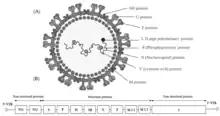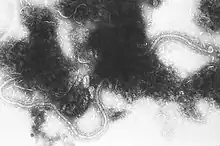Pneumoviridae
Pneumoviridae (from Greek pneumo- 'lung' + -viridae 'virus', from Latin, 'poison, slimy liquid')[2][3] is a family of negative-strand RNA viruses in the order Mononegavirales.[1][4] Humans, cattle, and rodents serve as natural hosts.[5] Respiratory tract infections are associated with member viruses such as human respiratory syncytial virus. There are five species in the family which are divided between the genera Metapneumovirus and Orthopneumovirus. The family used to be considered as a sub-family of Paramyxoviridae, but has been reclassified as of 2016.[1]
| Pneumoviridae | |
|---|---|
 | |
| Pneumovirus structure and genome | |
 | |
| Transmission electron micrograph of Human orthopneumovirus | |
| Virus classification | |
| (unranked): | Virus |
| Realm: | Riboviria |
| Kingdom: | Orthornavirae |
| Phylum: | Negarnaviricota |
| Class: | Monjiviricetes |
| Order: | Mononegavirales |
| Family: | Pneumoviridae |
| Genera[1] | |
Virology
Structure
Pneumoviruses are pleomorphic, capable of producing spherical and filamentous, enveloped virions (virus particles) that vary in size from 150 to 200 nm in diameter. The nucleocapsid consisting of a protein shell and viral nucleic acids has a helical symmetry. Nucleocapsids have a diameter of 13.5 nm and a helical pitch of 6.5 nm.[6]
Genome
The genome is composed of negative-sense, single-stranded RNA that is non-segmented. It is about 15 kbp in size, and encodes eleven proteins.[5] A unique feature of the genome is the M2 gene, which encodes proteins M2-1 and M2-2. The pneumovirus M2-1 protein is distinctive, and no homologue has been found in any other virus families. It functions as a processivity factor for the virus RNA-dependent RNA polymerase, and promotes viral RNA synthesis.[7] Viruses in this family are often associated with respiratory infections, and are transmitted through respiratory secretions.[5]
Proteins
N – Nucleocapsid protein. Essential for viral replication and transcription. Plays a major role in forming a capsid around the viral genome.[8]
P – Phosphoprotein required for replication.[8] Facilitates RNA-dependent RNA polymerase attachment and recruits M2 protein.[9]
M1 – Matrix protein. Facilitates nucleocapsid and envelope interactions.[10]
M2-1 – Matrix protein. Intragenic and intergenic transcription factor required for mRNA transcript elongation.[8] Binds to nascent and provides stability in order to prevent premature termination.[11]
M2-2 – Matrix protein. Involved in regulating transcription and replication. When over expressed, has been shown to inhibit viral replication.[12]
F – Fusion protein. Type I glycoprotein that facilitates fusion between the virus and the host cell membrane.[13]
SH – Small hydrophobic protein. Non essential. Exact function is unknown. Suggested to alter membrane permeability and block apoptosis.[13][14]
G – Type II glycoprotein.[13] Facilitates virus attachment through interactions with glycosaminoglycans.[15]
L – RNA dependent RNA polymerase.[16] Required for replication.[8] Adds a methylated guanosine cap and poly(A) tail to nascent mRNA.[16]
Replication
Pneumoviruses replicate in the cytoplasm of the host cell.[1][5] First, the virus binds to HN glycoprotein receptors expressed on the surface of the cell.[5] Then, through the action of the fusion protein, the virus fuses to the host plasma membrane and the nucleocapsid is released.[5] Prior to undergoing replication, mRNA is transcribed and viral proteins are translated. Transcription is dependent on virally encoded RNA-dependent-RNA-polymerase, which binds the genome at the 3' leader region and then sequentially transcribes each gene. Translation of viral proteins is carried out by host cell ribosomes.[17][18] Once sufficient P, N, L, and M2 proteins are available to create a capsid around the newly replicated genome, the virus undergoes replication.[18] After replication, the P, L, and M proteins participate in forming the ribonucleocapsid. Once virion assembly is complete, the virion egresses by budding out of the cell.[18]
Infection in humans
Human metapneumovirus (HMPV) was first classified as a pneumovirus in 2001. It is a negative-strand RNA virus that is the second most common cause of lower respiratory infection in young children. Pneumoviruses are intermediate in size between viruses of the families Paramyxoviridae and Orthomyxoviridae. Cytoplasmic inclusions are considerably more dense than those of other viruses in the family. Human metapneumovirus infection is very similar to the common cold; it is an upper respiratory infection. It will typically occur in the winter and early spring. This specific infection is most common in children, especially under the age of five. Common symptoms include runny nose, congestion, sore throat, cough, headache, and fever, which can be seen as a cold. It will typically go away after a few days. If this is seen in people over 75, then there is a cause for concern as it can turn to pneumonia.[19][20][21][22][23]
Taxonomy
| Genus | Species | Virus (Abbreviation) |
| Metapneumovirus | Avian metapneumovirus | avian metapneumovirus (AMPV) |
| Human metapneumovirus | human metapneumovirus (HMPV) | |
| Orthopneumovirus | Bovine orthopneumovirus | bovine respiratory syncytial virus (BRSV) |
| Human orthopneumovirus | human respiratory syncytial virus A2 (HRSV-A2) | |
| human respiratory syncytial virus B1 (HRSV-B1) | ||
| Murine orthopneumovirus | murine pneumonia virus (MPV) | |
References
- "ICTV Online (10th) Report".
- "Online Etymology Dictionary". www.etymonline.com. Retrieved 2016-12-14.
- "Online Etymology Dictionary". www.etymonline.com. Retrieved 2016-12-14.
- Afonso, Claudio L.; Amarasinghe, Gaya K.; Bányai, Krisztián; Bào, Yīmíng; Basler, Christopher F.; Bavari, Sina; Bejerman, Nicolás; Blasdell, Kim R.; Briand, François-Xavier (2016-08-01). "Taxonomy of the order Mononegavirales: update 2016". Archives of Virology. 161 (8): 2351–2360. doi:10.1007/s00705-016-2880-1. ISSN 1432-8798. PMC 4947412. PMID 27216929.
- "ViralZone: Pneumovirus". viralzone.expasy.org. Retrieved 2016-12-14.
- Gutsche, Irina; Desfosses, Ambroise; Effantin, Grégory; Ling, Wai Li; Haupt, Melina; Ruigrok, Rob W. H.; Sachse, Carsten; Schoehn, Guy (2015-04-16). "Near-atomic cryo-EM structure of the helical measles virus nucleocapsid". Science. 348 (6235): 704–7. Bibcode:2015Sci...348..704G. doi:10.1126/science.aaa5137. ISSN 0036-8075. PMID 25883315. S2CID 206634912.
- Kuhn, Jens H. (November 2015). "Elevation of the paramyxoviral subfamily Pneumovirinae to family status as family Pneumoviridae in the order Mononegavirales; and renaming of one pneumoviral genus" (PDF). ICTV. Archived from the original (PDF) on 2016-09-10. Retrieved 2016-12-14.
- Stokes, H. L.; Easton, A. J.; Marriott, A. C. (2003-01-01). "Chimeric pneumovirus nucleocapsid (N) proteins allow identification of amino acids essential for the function of the respiratory syncytial virus N protein". Journal of General Virology. 84 (10): 2679–2683. doi:10.1099/vir.0.19370-0. PMID 13679601.
- Renner, Max; Bertinelli, Mattia; Leyrat, Cédric; Paesen, Guido C.; Oliveira, Laura Freitas Saraiva de; Huiskonen, Juha T.; Grimes, Jonathan M. (2016-02-15). "Nucleocapsid assembly in pneumoviruses is regulated by conformational switching of the N protein". eLife. 5: e12627. doi:10.7554/eLife.12627. ISSN 2050-084X. PMC 4798948. PMID 26880565.
- Thomas., Leitner (2002-01-01). The Molecular Epidemiology of Human Viruses. Springer US. p. 330. OCLC 852790083.
- Leyrat, Cedric; Renner, Max; Harlos, Karl; Huiskonen, Juha T.; Grimes, Jonathan M. (2014-05-19). "Drastic changes in conformational dynamics of the antiterminator M2-1 regulate transcription efficiency in Pneumovirinae". eLife. 3: e02674. doi:10.7554/eLife.02674. ISSN 2050-084X. PMC 4051120. PMID 24842877.
- Cheng, Xing; Park, HyunJung; Zhou, Helen; Jin, Hong (2005-11-15). "Overexpression of the M2-2 Protein of Respiratory Syncytial Virus Inhibits Viral Replication". Journal of Virology. 79 (22): 13943–13952. doi:10.1128/JVI.79.22.13943-13952.2005. ISSN 0022-538X. PMC 1280200. PMID 16254330.
- Melero, José A.; Mas, Vicente (2015-11-02). "The Pneumovirinae fusion (F) protein: A common target for vaccines and antivirals". Virus Research. Special Issue: Cell response to viral infection. 209: 128–135. doi:10.1016/j.virusres.2015.02.024. PMID 25738581.
- Graaf, Miranda de; Herfst, Sander; Aarbiou, Jamil; Burgers, Peter C.; Zaaraoui-Boutahar, Fatiha; Bijl, Maarten; IJcken, Wilfred van; Schrauwen, Eefje J. A.; Osterhaus, Albert D. M. E. (2013-03-06). "Small Hydrophobic Protein of Human Metapneumovirus Does Not Affect Virus Replication and Host Gene Expression In Vitro". PLOS ONE. 8 (3): e58572. Bibcode:2013PLoSO...858572D. doi:10.1371/journal.pone.0058572. ISSN 1932-6203. PMC 3590193. PMID 23484037.
- Thammawat, Sutthiwan; Sadlon, Tania A.; Hallsworth, Peter G.; Gordon, David L. (2008-12-01). "Role of Cellular Glycosaminoglycans and Charged Regions of Viral G Protein in Human Metapneumovirus Infection". Journal of Virology. 82 (23): 11767–11774. doi:10.1128/JVI.01208-08. ISSN 0022-538X. PMC 2583676. PMID 18786997.
- Paesen, Guido C.; Collet, Axelle; Sallamand, Corinne; Debart, Françoise; Vasseur, Jean-Jacques; Canard, Bruno; Decroly, Etienne; Grimes, Jonathan M. (2015-11-09). "X-ray structure and activities of an essential Mononegavirales L-protein domain". Nature Communications. 6: 8749. Bibcode:2015NatCo...6.8749P. doi:10.1038/ncomms9749. ISSN 2041-1723. PMC 4659945. PMID 26549102.
- Easton, Andrew J.; Domachowske, Joseph B.; Rosenberg, Helene F. (2017-05-01). "Animal Pneumoviruses: Molecular Genetics and Pathogenesis". Clinical Microbiology Reviews. 17 (2): 390–412. doi:10.1128/CMR.17.2.390-412.2004. ISSN 0893-8512. PMC 387412. PMID 15084507.
- Panda, Swagatika; Mohakud, Nirmal Kumar; Pena, Lindomar; Kumar, Subrat (2014). "Human metapneumovirus: review of an important respiratory pathogen". International Journal of Infectious Diseases. 25: 45–52. doi:10.1016/j.ijid.2014.03.1394. PMC 7110553. PMID 24841931.
- "Pneumovirus". The Free Dictionary.
- "Learn About Human Metapneumovirus (hMPV)". American Lung Association. Retrieved 2016-05-13.
- "Wolters Kluwer Health - Article Landing Page". pt.wkhealth.com. Retrieved 2016-05-13.
- Bao, Xiaoyong; Liu, Tianshuang; Shan, Yichu; Li, Kui; Garofalo, Roberto P.; Casola, Antonella (2008-05-30). "Human Metapneumovirus Glycoprotein G Inhibits Innate Immune Responses". PLOS Pathog. 4 (5): e1000077. doi:10.1371/journal.ppat.1000077. ISSN 1553-7374. PMC 2386556. PMID 18516301.
- Peiris, J.S. Malik; Tang, Wing-Hong; Chan, Kwok-Hung; Khong, Pek-Lan; Guan, Yi; Lau, Yu-Lung; Chiu, Susan S. (2003-06-01). "Children with Respiratory Disease Associated with Metapneumovirus in Hong Kong". Emerging Infectious Diseases. 9 (6): 628–633. doi:10.3201/eid0906.030009. ISSN 1080-6040. PMC 3000155. PMID 12781000.
- Amarasinghe, Gaya K.; Bào, Yīmíng; Basler, Christopher F.; Bavari, Sina; Beer, Martin; Bejerman, Nicolás; Blasdell, Kim R.; Bochnowski, Alisa; Briese, Thomas (2017-04-07). "Taxonomy of the order Mononegavirales: update 2017". Archives of Virology. 162 (8): 2493–2504. doi:10.1007/s00705-017-3311-7. ISSN 1432-8798. PMC 5831667. PMID 28389807.